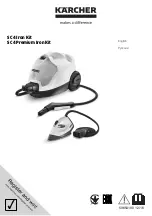
F116 (SERIES 16000) SELF-CONTAINED DUCTABLE COMMERCIAL AIR CLEANER
68-0200
14
Removing Specific Contaminants from Cells
Table 5 lists the appropriate cleaning procedure for types of
contamination often found on cells. Cleaning procedures are
listed in order of preference. Be careful to avoid bending the
cell collector plates.
Table 5. Recommended Cleaning Procedures
for Specific Contaminants.
Contaminant
Cleaning Procedure
Animal hair solution
Dishwasher detergent
Carbon
(carbon black, soot, lamp
black, graphite, charcoal
dust)
Dishwasher detergent solution
high pressure air or
high pressure water
Cooking oils:
Vegetable (soybean,
peanut) or animal (lard,
butter)
Dishwasher detergent solution
or steam
Cotton fibers solution
Dishwasher detergent solution
Dust
(silicon dioxide, calcium
carbonate and mineral
type compounds)
Dishwasher detergent solution
Flour dust
Dishwasher detergent solution
Mineral oil
(petroleum base, diesters
and silicone)
Dishwasher detergent solution
or high pressure water
Paper products
Dishwasher detergent solution
Paint
(oil base or water base)
Dishwasher detergent solution
Pine tar resins
Dishwasher detergent solution
or steam
Soaps
Dishwasher detergent solution
Sodium chloride
Dishwasher detergent solution
Sugars
(all types including
molasses)
Dishwasher detergent solution
or steam
Talc
High pressure air
or
Dishwasher detergent solution
Tobacco tars and smoke
Dishwasher detergent solution
Varnishes
Dishwasher detergent solution
Waxes (all types)
Dishwasher detergent solution
or steam
Reinstalling the Cells
1. Inspect the cells for broken ionizer wires and bent
collector plates. Bend warped or bent collector plates
back into shape. For maximum efficiency, replace
broken ionizer wires as instructed in Replacing Ionizer
Wires section.
2. Wipe ionizer wires.
3. Check that cells are completely dry before reinstalling in
the air cleaner. If cells are placed into the air cleaner
while still wet, the electronic cells can short out and arc
frequently when almost dry. Although the system
appears to be operating, the cells may not be cleaning
during the drying period.
4. Check that the ionizer wire side of the cell is the farthest
from the fan.
5. Wipe surface dirt from the inside of the cabinet.
6. Ease the edge of the cell into the cabinet.
7. Replace the prefilter and any other primary filters.
8. Close and carefully latch the door.
Replacing Ionizer Wires
Broken or bent ionizer wires can cause an electrical short to
ground, often resulting in visible arcing or sparking. Remove
broken wires. Cells can be used temporarily with one wire
missing, but replace the wire as soon as possible.
Replacement wires are cut to length with a T-fastener on one
end and a spring on the other end for easy installation. To
install:
1. Slip the ionizer wire T-fastener into a vacant wire key
slot. See Fig. 21. Be careful to avoid damaging the
ionizer wire or other parts of the cell.
2. Use a needlenose pliers to hold the opposite end of the
wire and stretch the wire the length of the cell. Insert
the spring loop into the wire hole.
3. Check the cell for short circuits using an ohmmeter. See
Fig. 22. Check the resistance between the frame of the
cell and both the ionizer and the collector contacts. In
each case, the resistance should be infinite.
PULL
OUT
T-FASTENER
IONIZER
WIRE
PRESS
UP
IONIZER
WIRE
ATTACHMENT
HOLE
NEEDLENOSE
PLYERS
M7787
Fig. 21. Install new ionizer wire by hooking
spring loop end over wire hole edge.






































